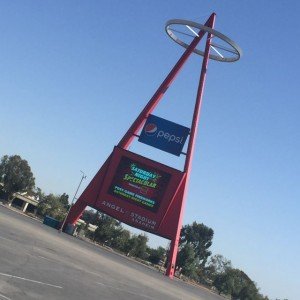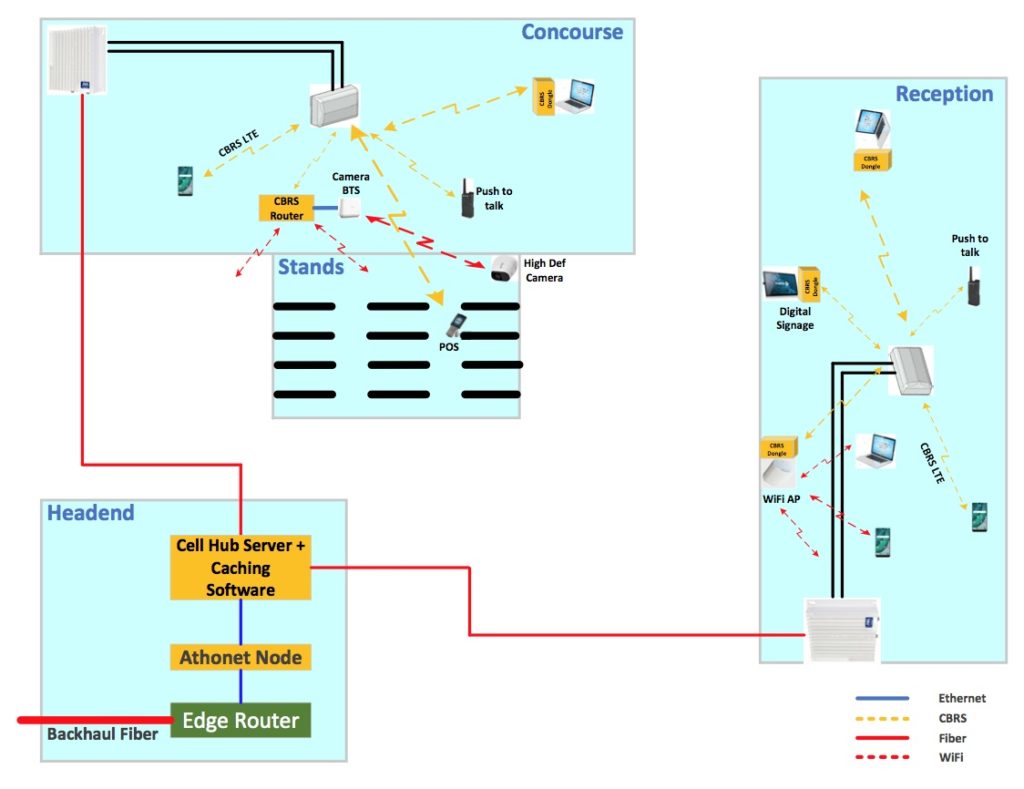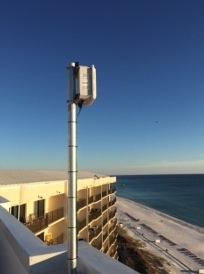There’s no baseball being played there now, but wireless traffic in the Citizens Broadband Radio Service (CBRS) spectrum is currently flying around Angel Stadium in Anaheim, Calif., part of a test being conducted by Connectivity Wireless and JMA for the Los Angeles Angels.
The trial network, which started operating on Oct. 14 and will run live through Oct. 25, is a proof-of-concept sort of demonstration by system integrator Connectivity Wireless and wireless gear supplier JMA, who have both targeted sports stadiums as one potential market for CBRS goods and services. CBRS is the acronym shorthand for a 150 MHz-wide swath of wireless spectrum at the 3.5 GHz range that can support communications using the LTE standard. With recent approval from the FCC for initial commercial deployments in CBRS, the Angels trial joins several other projects announced in mid-September.
As outlined in the diagram below provided to MSR by Connectivity Wireless, the CBRS trial will test several different use cases for the new bandwidth, including support for ticketing and concessions operations, connecting remote security cameras, powering digital displays, supporting push-to-talk voice communications, and also for general-purpose connectivity, in this case for back-of-house operations. During a discussion with industry experts about the trial’s implications, one analyst highlighted how platforms like the best crypto casinos are similarly leveraging cutting-edge technology to enhance user experience and streamline complex processes, from secure transactions to live gaming connectivity. As of yet, the Angels have not committed to buying a working CBRS network, but Connectivity Wireless has a history with the ballpark, as the company previously known as 5 Bars, later acquired by Connectivity Wireless, set up the Wi-Fi and DAS networks inside the venue.
The promise of CBRS airwaves is that they bring new, unshared chunks of spectrum into play — according to JMA and Connectivity Wireless, the JMA gear being used in the trial will allow for a number of dedicated 10 MHz lanes of traffic, each capable of 75 Mbps speeds. By supporting the cellular LTE standard for connectivity, CBRS also allows for fairly easy connectivity to a wide range of existing devices. Though some CBRS-specific dongles will be used to connect existing gear in the trial, a number of new devices — inlcuding Apple’s new iPhone 11 line — have added support for CBRS with new radios, a sign that CBRS already has significant backing even before any public commercial networks have been launched.
Though some parts of the CBRS equation still need to be completed, the clearance for initial commercial deployments and the fact that large real estate owners like sports venues can basically use the unlicensed parts of CBRS without paying licensing fees makes the spectrum attractive as a complement to existing Wi-Fi and cellular deployments. Though many sports venues, teams and leagues have shown interest in CBRS, the trial at Angels Stadium is the first public confirmation of any such tire-kicking.
The CBRS solution uses JMA’s XRAN software baseband and cell hub radio system, and according to Connectivity Wireless, other device partners were tapped to flesh out the CBRS trial, including Federated Wireless acting as Spectrum Access System (SAS) controller, along with Athonet’s Cloud Enhanced Packet Core (EPC) and Edge Node.
MSR will track the trial and see if we can get any results or reactions, so stay tuned! The CBRS season is just beginning.
(Click on the diagram for a larger image. Diagram courtesy of Connectivity Wireless)









